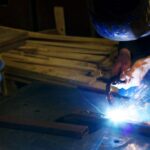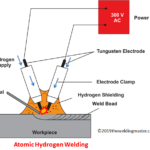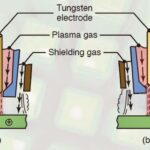Introduction
Welding is the joining process frequently used to join two parts (or called a Workpiece). The machining and Casting Process can’t produce all the required components alone, and the requirement of the joining process is essential. If we define this process, it is a joining process in which base material (Workpiece) and filler material melt to complete the joining. This article will discuss Laser Beam Welding in detail, its type, working, advantages, disadvantages, and precautions required.
Definition
Laser Beam Welding is used to join two materials (mostly metals and thermoplastics) using laser beams concentrated at a point. It is one of the most frequently used joining techniques in the industry, and due to Industrial Automation, its use is increasing day by day. In this type, a Laser Beam is directed to the cavity between the two workpieces. Due to high temperature, the workpiece melts, bonds with each other, and cools instantly. The formed weld is solid as compared to weld formation due to other conventional methods.

Fig. 1: Laser Beam Welding
Types of Laser Beam Welding
We can classify welding on various bases, for example, based on Level of Automation, Filler Material, Laser Beam, Etc. Under this article, we will be studying different types on different bases.
1. Based on the Mechanism of Welding:
Based on this, it can be divided into two different types, which are discussed below-
(i) Heat Conduction Welding:
In this type of Welding, the metal is melted but not vaporized. The requirement of Power for a Laser is also less, and the final finished Surface is very smooth.
(ii) Keyhole Welding:
In this type of Welding process, the cavity between the two workpieces is melted, and the Laser reaches deep into the metal, forming a Plasma core with a very high temperature. The Power requirement for this type of Welding process is very high.
2. Based on Types of Lasers Used:
Based on the types of Lasers used, it can be divided into three different types, which are discussed below-
(i) Gas Lasers:
This type uses a mixture of gases as a Laser Medium. These can include Nitrogen, helium, and carbon-di-oxide.
(ii) Solid- State Laser:
This type of Laser uses Solid state compounds as Laser Medium, which can Include, synthetic ruby crystal, neodymium in yttrium aluminum garnet, Etc.
(iii) Fibre Laser:
This uses Optical fiber as the laser medium. They are used for Robotics Industrial Welding.
3. Based on Laser Beam Delivery:
Based on types of Laser Beam delivery, it is divided into two different types, which are as follows-
(i) Traditional type:
In this type, the laser output is moved to follow a seam. It is achieved with the help of robotics coded to perform the task.
(ii) Remote type:
In this type, the Laser Output detects the seam with the help of Laser scanning, and no robot is required to do the same.
3. Main Components and Its Functions
This type of Welding is different from the Other Types of Conventional Welding. It is Integrated with various computers to perform the task. The following list contains the Major components used and their functions:
(i). Power Source:
A high Voltage Source is required at the two ends of the Machine to produce a highly concentrated Laser Beam
(ii). Laser Machine:
It consists of various components used to produce Laser when provided with sufficient voltage difference.
(iii). CAM:
It stands for computer-aided manufacturing. It defines the Code (G and M code mainly) to control the direction and speed for the Motion of Welding machine to direct the Welding at a given Location.
(iv). CAD
It stands for Computer-Aided design, which is used to visualize the Workpiece and Process by designing it in Software.
(v). Shielding Gas:
Shielding gas is used to stop the Workpiece from Oxidising at such a High temperature.
Also Read:
- What is Shielded Metal Arc Welding ?- Complete Explanation
- What is Slotter Machine – Parts, Types, Working, Operations, Advantages and Disadvantages?
- Laser Beam Machining – Main Parts, Principle, Working with Application
4. Working Of Laser Beam Welding

To Study the Working in a simple way, we have divided it into different steps, which are as follows:
1. Location of Machine:
With the help of various controllers, the Welding Machine is located at the point where the joining process is to be done. This is performed using CAM codes, which take it to the desired position.
2. Production of Laser Beam:
The Applied Voltage difference at the end produces a flash on the Laser machine, which emits the photons (Highly energized). The emitted photons strike the Laser Beam medium (either gas Laser, Solid-state Laser, and Fiber Laser) that Produces Highly energized electrons, which multiply and produce a highly concentrated Laser Beam.
3. CAM Control:
After Production of the Laser Beam, the CAM Codes moves the Laser Welding machine to the desire location and the Welding of the Joint starts.
4. Melting and Solidification of Joint:
The Directed Laser Beam along with the Joint heats and melts the metal to its core. The Melted metal forms the Joint with each Other and is suddenly cooled. The solidified part is the Weld and is much stronger than the Weld produced by Other Welding Processes.
To know more about how Laser Beam Welding Works? Watch the Video:
6. Advantages and Disadvantages:
Laser Beam Welding is one of the advanced Welding Processes and is perfect for industries moving towards complete Automation. There are some advantages and disadvantages of this type of Welding process, which are discussed as follows:
Advantages:
- It is a fully Automatic Process, leading to an Increase in Productivity in the Industries.
- The Weld Joint forms are stronger than Other conventional Welding Processes.
- CAM Codes can easily control the Process using certain Process parameters.
- The Heating of Metal is limited to a very small area around the Weld and does not affect other areas.
- Vacuum is not required.
- Low distortion of the Workpiece during the Welding.
Disadvantages:
- The Initial Cost of the complete Setup is very high.
- Highly Skilled Worker is required to control the Laser Beam Welding Machine.
- The Efficiency of the Process is very low, which is less than 10%.
- Due to fast cooling after the heating process, can produce fracture in the Material.
7. Future of Laser Beam Welding:
Laser Beam Welding is One of the modern Welding techniques perfect for the current Industrial requirements. The Industry is moving towards complete automation, and CAD and CAM are increasing day by day. Laser Beam Welding is one of the processes that fit perfectly in the given criteria. It can be easily controlled through CAM Codes and controllers and can be designed in CAD Softwares for visualization. We will frequently see these types of Welding techniques dominating over other types of Welding in the coming future. Currently, Industries are using Other types of the Welding process, but this is the most used Ones and will be in the future.
FAQs:
Q1: What is Seam in Welding?
Ans: The Path or Profile in the Welding is called the seam. It can be treated as a separate Welding process, which is a type of Resistance Welding.
Q2: What is the level of Automation achieved using this Welding process?
Ans: Laser Welding is used in the Industries with complete Automation. Hence, it can be used in Industries with complete Automation to the Industries using Manual techniques.
Q3: What are some of the recommended precautions while using this Welding?
Ans: Some precautions include, using PPE (Personal Protective Equipment), don’t see directly the Laser produced and don’t touch the freshly welded Surface with bare hands.








